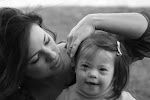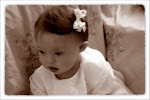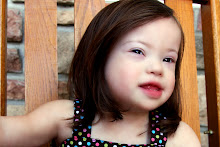I've read about Amy making the decision to apply for handicapped parking permission for her daughter Larkin, how Ellen struggled with her application for a MR waiver for Nichole, and how Lisa ponders her son Finn's future and Ds stereotypes in response to the "Johnny the Bagger" story.
Parents protect their children fiercely. This is not unique to parenting a child with a disability. What is different is that our children are universally perceived as different--and as such, we feel the need to protect, even more fiercely, from the very beginning. Most of us are sensitive to images, language, and perspectives that have real power to limit our children (and to stomp on our hearts at the same time).
We are in a unique position. We do live in a "different world" in many ways. And although it's a world of many, many, untold blessings, it is also a world where questions, fears and soul-searching are part of the everyday landscape.
You might not see it often on Bridget's Light, but I have my tough days, too. We all have our moments when things seem out of control, overwhelming or filled with with uncertainty. It comes in waves. The waves were much bigger and flattened me a few times when Bridget was tiny. Today I'm finding that I don't have to jump nearly as high or as often to make it over them. As a family, we have found our center of balance, and have learned to accept and celebrate our lives as they are today. Jumping waves is much easier when you're holding hands with someone you love.
My goal with this blog has always been to share Bridget--and our experiences with her--with friends, family and anyone else who might benefit. I'm committed to finding ways of highlighting the importance of advocacy, keeping perspective and seeing possibility. To that end, I want to share the following:
Bridget was very small when we were first introduced to the Buddy Walk. We chose not to participate in the Buddy Walk that fall, but a friend brought us a bag with pamphlets, stickers, magnets and brochures that were given out that day. In it, I found a bright pink sheet of paper. Printed on it was the following story, which had great impact on me at the time. I found this again recently while I was re-organizing my file box for Bridget, and it still resonates with me deeply...
_________________________________________________
A Story about My Two Daughters
How to Live in the World of Possibility
My second daughter is a sophomore in college. She is majoring in science. She loves anatomy and physiology, biology and anything connected to science. She loves to read but because of a vision loss she needs to take frequent breaks. She has a hearing loss so it helps if she can see the speaker and keep background noise to a minimum. Recently, she has become very interested in sketching portraits. Because of this new interest she is taking a course in advanced drawing. She is popular – the life of the party. She loves to flirt – in fact, her senior class in high school voted her most flirtatious. She has many friends. She has the ability to make other people feel welcome and loved. She is persistent, loves having fun and has a great personality. She loves to dance, travel and write to and receive letters from friends. She dreams of starting her own rock band.
The story of my two daughters illustrates the power of our words and our perspectives. It illustrates the power of the scientific processes and the labels we continue to use to diagnose, predict and sort people.
How? Both stories are about the same person, my daughter.
The story about my "first daughter” was constructed from exact words and phrases found on my daughter's school and employment related documents, written in the language of professionals, educators, psychologists and job specialists. It tells what she can’t do, won’t do and why. In this story, she is in need of repair, and thus in need of lots of professionals to fix her. The purpose of this story, in part, is compliance with federal and state regulations. The first consequence is that we (and the rest of society) accept the story as true and begin to adopt the language and beliefs and practices. Once that happens, the sad consequence is segregation, a client’s life, a planned life surrounded by professionals. The assumption in the story about my first daughter is that she is needy, broken, difficult and – most important – that her life should be safe and predictable surrounded by the service system.
The story about my “second” daughter was constructed from love, experience and by paying attention to gifts. It is told from the perspective that my daughter has immeasurable capacity once she has a valued and connected life in her community. The story about my second daughter is shaped (and lived) from a capacity perspective. This story is told in “context” of a life connected to others, a life that unfolds in exciting and unexpected ways precisely because of the many relationships she has. The consequences of this story are community and risk taking and surprises. The consequence is citizenship. The assumption in the story about my second daughter is that she is person who has capacity, interests, gifts, and contributions especially when her life unfolds in the presence of and participation in community.
The story of my two daughters represents two different worlds – the world of measurement and the world of possibility. Often, as my daughter grew up, I felt the overwhelming gravity of the world of measurement, pulling her toward specialized services and segregation with the promise of safety, and simplicity, and repair. In the world of measurement you get to know others by measuring and comparing. But it is the world of possibility that I find most powerful and promising.
The story about my second daughter is the story of possibility. It is the NEW story that we must learn to tell. It is the story told (and lived) from a capacity perspective, from a community perspective. We can learn to tell this NEW story by first examining our own perceptions and advocacy efforts. We can learn to tell the NEW story by listening, seeing, asking, discovering and taking action in the direction of gifts and capacities. We can learn to LIVE the NEW story by supporting rich relationships and taking actions that lead to more inclusive opportunities in our schools and in our communities, for it is these rich inclusive and ordinary experiences that will yield the context necessary to live in the world of possibility.
Copywrite 2006, Candee Basford
**An article by John O’Brien and Beth Mount inspired this essay. It is titled “Telling New Stories, The Search for Capacity Among People with Severe Disabilities” .
***For more on how to live in possibility read “The Art of Possibility” by Zander and Zander.



















